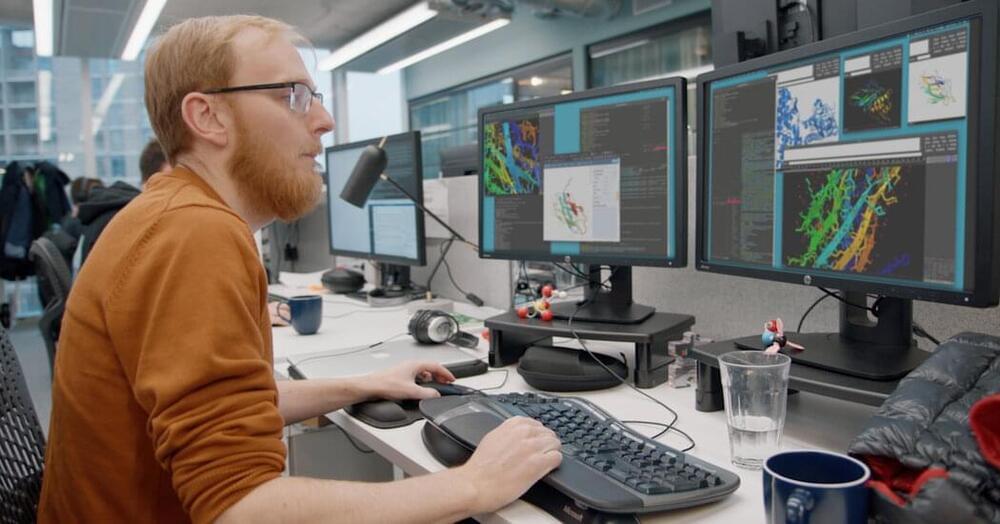DeepMind has given 3D structure to 350,000 proteins, including every one made by humans, promising a boon for medicine and drug design.



The NASA VIPER rover – a precursor mission to human landings in the south polar region of the Moon, and a mission started in 2019 under the Commercial Lunar Payload Services program – has had its landing site selected for its 2023 mission. The rover, known as the Volatiles Investigating Polar Exploration Rover, is now scheduled to land west of Nobile Crater in the lunar south polar region sometime in late 2023 after its launch aboard a SpaceX Falcon Heavy rocket.
This mission, costing $660 million, is one of several that will launch to the Moon in the next two years and is notable for being the first NASA rover to launch as a customer aboard a commercial lander.
The golf cart-sized VIPER rover will be mounted onto a Griffin lunar lander built by Astrobotic, a Pittsburgh-based company developing various lunar spacecraft that can carry payloads into lunar orbit or onto the lunar surface. After landing, VIPER will roll out onto the lunar surface with the help of a pair of ramps mounted on the lander and conduct checkouts before starting its surface mission.
It turns out, Mars was always fated for a waterless destiny.
New observations from robotic explorers like NASA’s Perseverance and Curiosity have revealed much about the ancient past of the Red Planet, where liquid water flowed throughout the planet’s surface. It used to have lakes, streams, rivers, and perhaps even a colossal ocean stretching around the horizon of Mars’ northern hemisphere. For decades, scientists have thought the weakening of the Martian magnetic field enabled charged particles from the sun to strip away the atmosphere, literally blowing away the bodies of water.
But a deeper, more primary cause for the move from wetness has come to light: Mars was always too small to retain its surface water forever, according to a new study published in the journal Proceedings of the National Academy of Sciences.

Circa 2021
A crime is a deliberate act that can cause physical or psychological harm, as well as property damage or loss, and can lead to punishment by a state or other authority according to the severity of the crime. The number and forms of criminal activities are increasing at an alarming rate, forcing agencies to develop efficient methods to take preventive measures. In the current scenario of rapidly increasing crime, traditional crime-solving techniques are unable to deliver results, being slow paced and less efficient. Thus, if we can come up with ways to predict crime, in detail, before it occurs, or come up with a “machine” that can assist police officers, it would lift the burden of police and help in preventing crimes. To achieve this, we suggest including machine learning (ML) and computer vision algorithms and techniques.

Circa 2019
Crime causes significant damage to the society and property. Different kinds of physical or direct methods are devised by the law and order department to spot out the criminals involved in the crime. This techniques will explore the evidences at crime site. For instance if it finds a fingerprint then the system will capture and send it to forensic department for fingerprint matching, which can be later used for identifying the suspects or criminals by investigations etc. Yet, it is a huge challenge for them to find the criminal due to less or no evidence and incorrect information, which can change the direction of investigation to the end. This paper proposes a data analysis approach to help the police department by giving them first-hand information about the suspects. It automates the manual process for finding criminal and future crime spot by using various techniques such as pattern matching, biometric and crime analytics. Based on the availability of information, the system is able to produce the expected accuracy.

From ecosystem development to talent, much effort is still required for practical implementation of edge AI.
By Pushkar Apte and Tom Salmon
Rapid advances in artificial intelligence (AI) have made this technology important for many industries, including finance, energy, healthcare, and microelectronics. AI is driving a multi-trillion-dollar global market while helping to solve some tough societal problems such as tracking the current pandemic and predicting the severity of climate-driven events like hurricanes and wildfires.

FedEx Corp. and self-driving vehicle startup Aurora Innovation Inc. are launching a pilot program for autonomous-truck shipments between Dallas and Houston, with the companies announcing Wednesday what they called a first-of-its-kind partnership involving the two companies and a truck maker.
“This is an exciting, industry-first collaboration that will work toward enhancing the logistics industry through safer, more efficient transportation of goods,” said Rebecca Yeung, vice president of advanced technology and innovation at FedEx FDX,-9.12% 0 in a news release.
I tried to warn them.-Elon Musk.
Elon Musk has warned humanity many times about the dangers of superhuman AI. He thinks the advent of digital superintelligence will bring about profound changes to human civilization. Elon Musk thinks the technological singularity could either be super beneficial or it could be terrible for our society. Elon said that no one knows for sure the impact superhuman AI will have on our world but that one thing is for certain: We will not be able to control it. He thinks artificial intelligence will be used as a weapon and warns that the lack of AI regulation could mean it’s already too late for humanity.
Elon Musk now has adopted a “fatalistic” attitude towards the AI control problem because he feels that nothing is being done to try to mitigate the negative effects of future AI systems.
The reasonable concern about a possible extinction level event from digital Superintelligence stems from the period of time in which Narrow AI achieves artificial general intelligence. Where presumably in this time frame we can do something to stack the odds in our favor.
Today, right now, with our seemingly endless desire for better, faster and cheaper technology, we are collectively contributing in building future AI systems. Whether we are aware of it or not. As Elon Musk put it: We are the biological bootloader for AI.

Science is examining the brain’s neural activity for applications ranging from innovative therapies for brain-related injuries and disease to computational learning architectures for artificial intelligence and deep neural networks.
A research team has developed a tool that lets researchers see more of a live mouse’s brain, to make discoveries that can advance research into the neural circuit mechanisms that form the underlying behavior of the human brain. The tool overcomes the drawback of traditional brain probes—the small amount of tissue they can access, which limits their ability to image neurons of interest.
The innovation is to insert an imaging probe with side-viewing capabilities into a previously inserted optically matched channel—an ultrathin-wall glass capillary—to convert deep brain imaging into endoscopic imaging. The operator can freely rotate the probe to image different brain regions, getting a 360-degree view for imaging along the entire length of the inserted probe. This large-volume imaging enables an increase of about 1,000 times in tissue access volume, compared with what is available for imaging at the tip of typical miniature imaging probes.

The pharmaceuticals firm GSK has struck a five-year partnership with King’s College London to use artificial intelligence to develop personalised treatments for cancer by investigating the role played by genetics in the disease.
The tie-up, which involves 10 of the drug maker’s artificial intelligence experts working with 10 oncology specialists from King’s across their labs, will use computing to “play chess with cancer”, working out why only a fifth of patients respond well to immuno-oncology treatments.